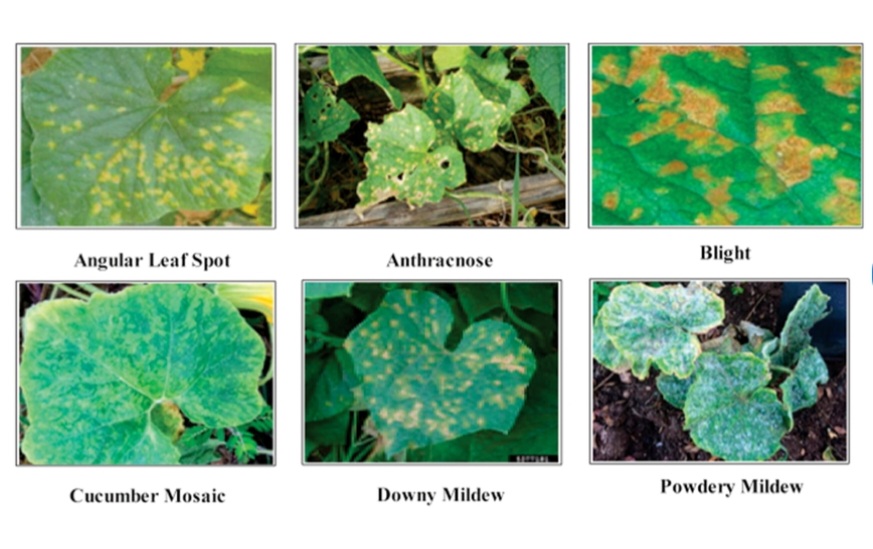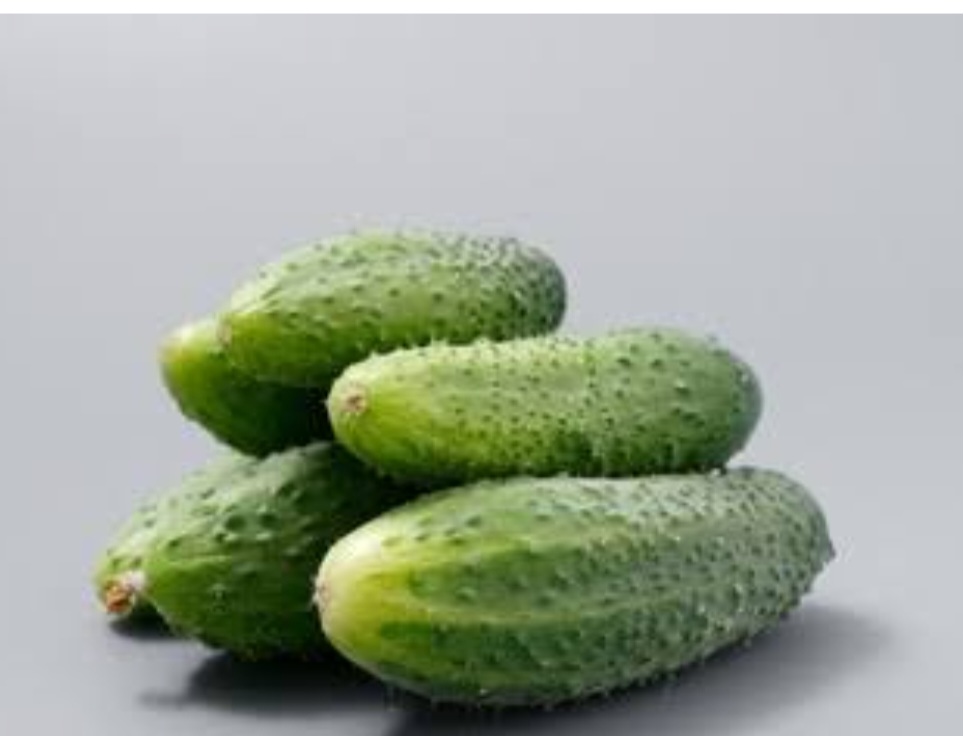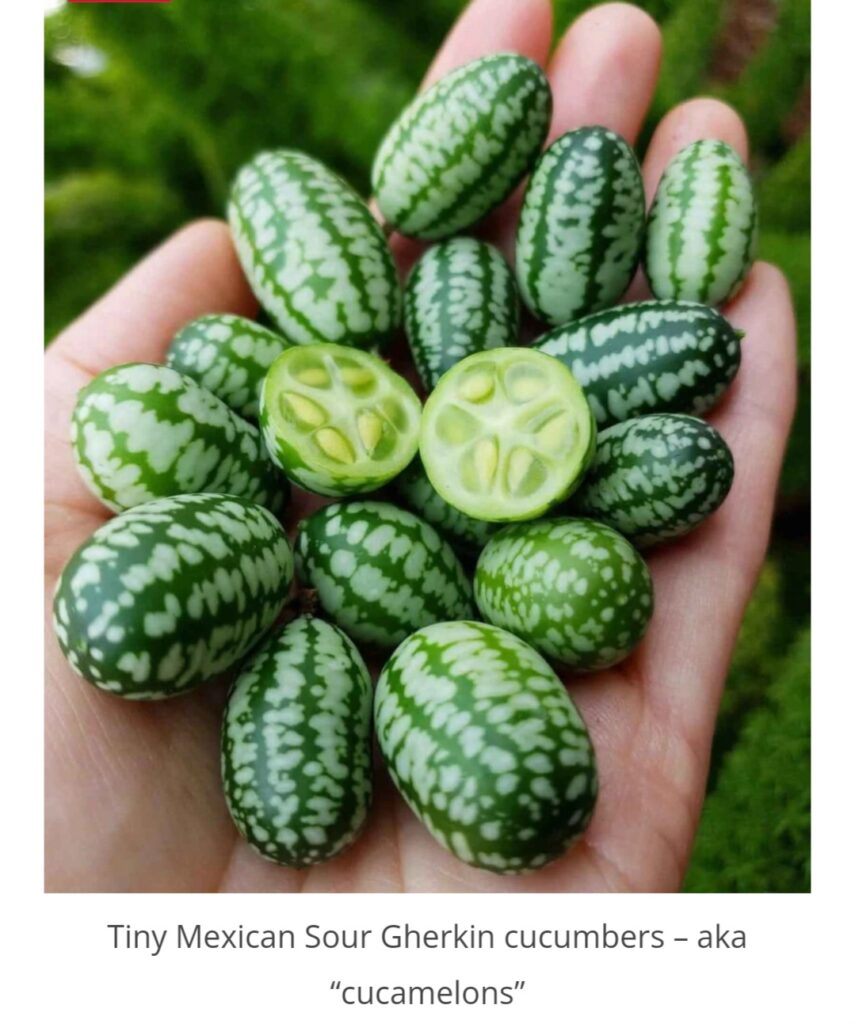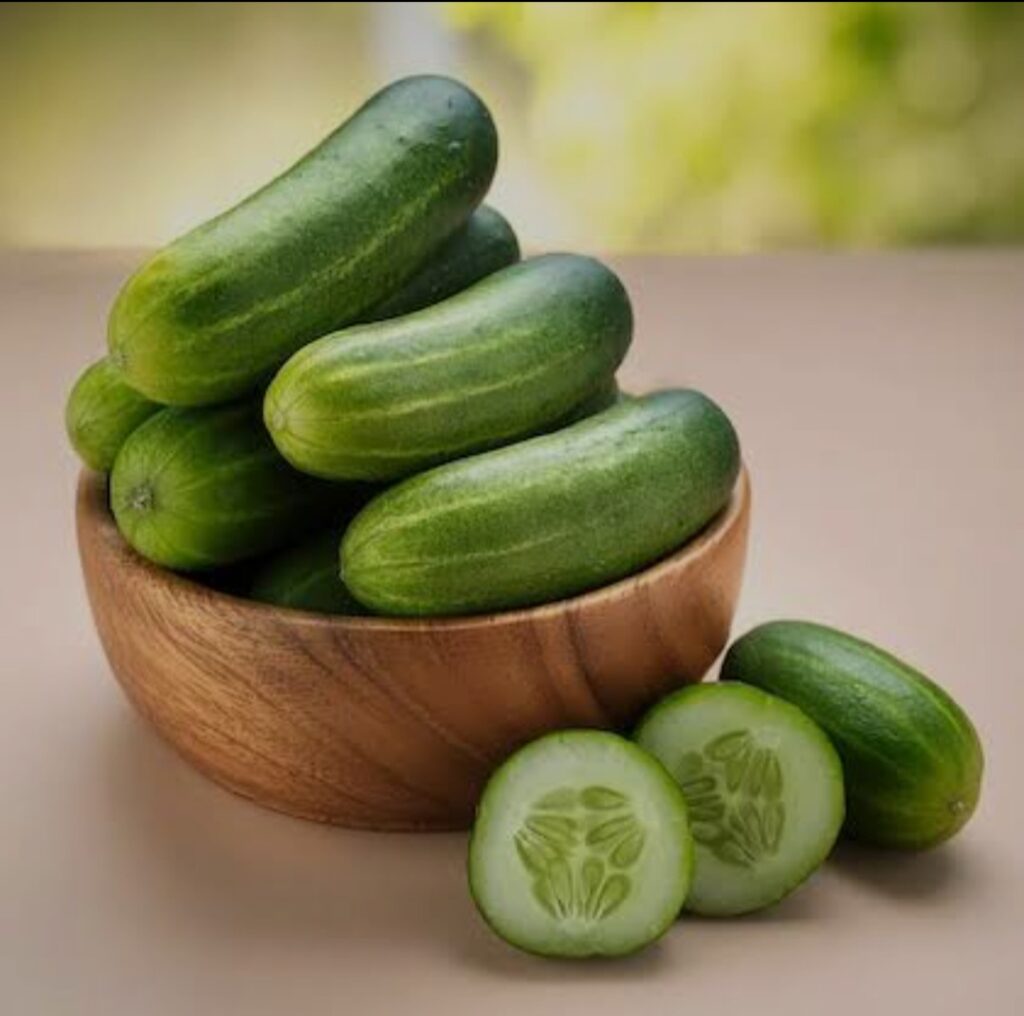
Cucumber (Cucumis sativus), is a creeping plant of the gourd family (Cucurbitaceae), belong to the order Cucurbitales and containing 98 genera and about 975 species. It is widely cultivated for its edible fruit.
Members of the family may be either annual or perennial herbs and are native to temperate and tropical areas. Some of the plants under the gourd family include cucumbers, gourds, melons, squashes, and pumpkins.
The cucumber fruit has low nutritional value but its delicate flavour makes it popular for salads and relishes. Small fruits of cucumber are often pickled.
Cucumbers are often mistaken for vegetables. But they are fruits, specifically berries.
Some of the common names of cucumber from other countries include : kut-ahun (Bunan), tangkuikut-ahun (Bunan), 黄瓜 (Chinese, simplified), 青瓜 (Chinese, traditional), okurka setá (Czech), gurke (German), cetriolo (Italian), 오이 (Korean), eckadamin (Ojibwe), ogórek siewny (Polish), pepino (Portuguese), oгурец обыкновенный (Russian), පිපිඤ්ඤා (Sinhala), pepino cohombro (Spanish), gurka (Swedish), bi-toni-castilla (Zapoteco)etc. In Nigeria, Hausa tribe call it – Kokwamba Yoruba- Kukumba, and Igbo- Kukumba.
DESCRIPTION
PLANT :
Cucumber plants are tender annual or perennial with a rough, succulent, trailing stems. They possess creeping vines that grow on trellises or other supports using spiraling tendrils. The plants have large leaves that form a canopy over the fruit.
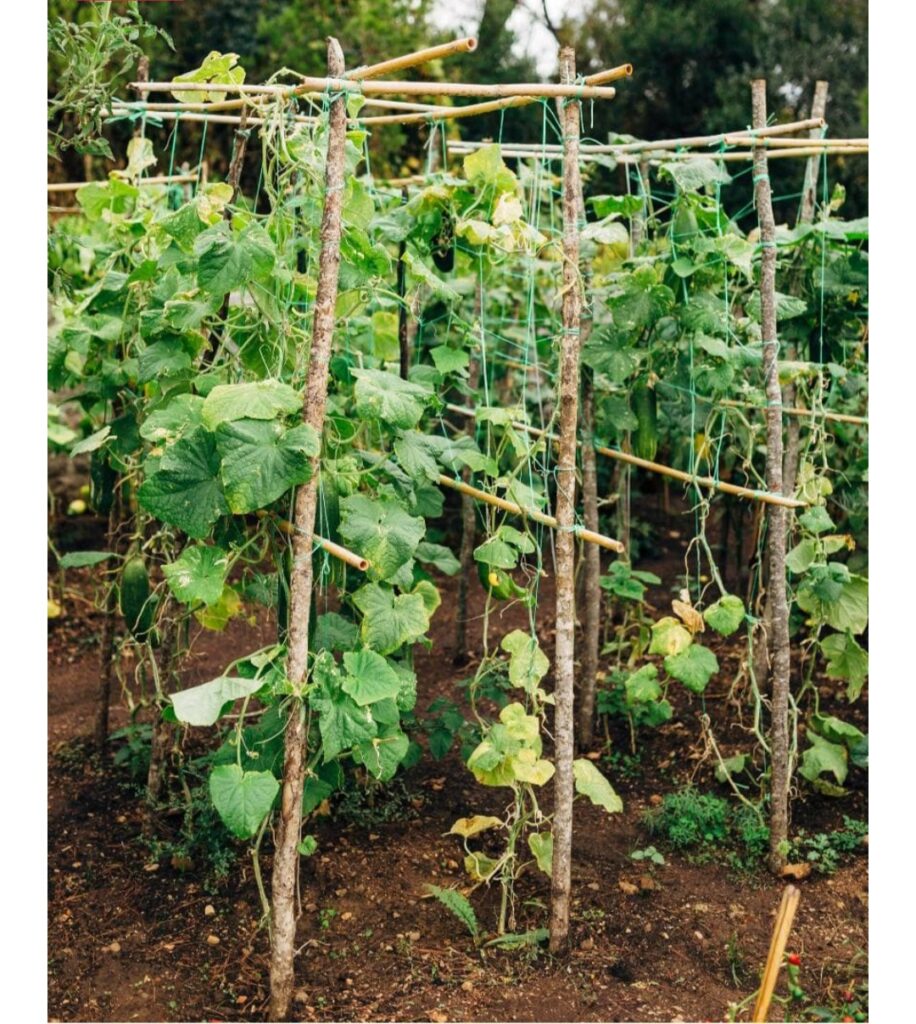
THE LEAVES: The leaves are hairy and have three to five pointed lobes.
THE STEM: The stem bears branched tendrils by which the plant can be trained to supports.
THE FLOWER: The flower has five-yellow petals which are unisexual and produce a type of berry known as a pepo after fertilization.
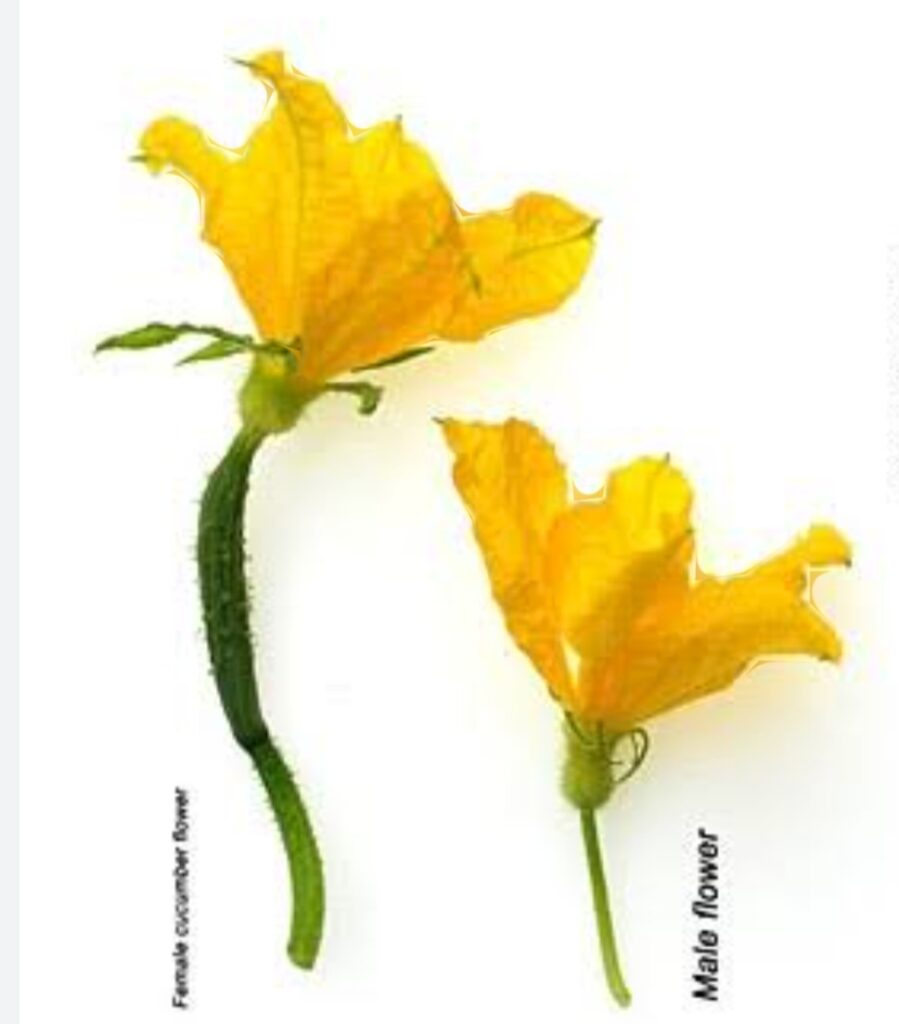
FRUITS: The cucumber fruit is a long, green, fleshy , berries fruit that is a member of the gourd family. They are made up of over 90% water, making them excellent for staying hydrated.
The fruits which are cylindrical with tapered ends, can be up to 24 inches long and 4 inches in diameter. They have a dark green outer skin and are pale green inside. They contain numerous numbers of seeds.
SEEDS
Cucumber seeds are whitish in colour, rich in oil and have a nutty flavor, but are difficult to use because they are small and covered in a fibrous coat.
VARIETIES
There are three main varieties of cucumber: slicing, pickling, and burpless. Under the varieties are different types.
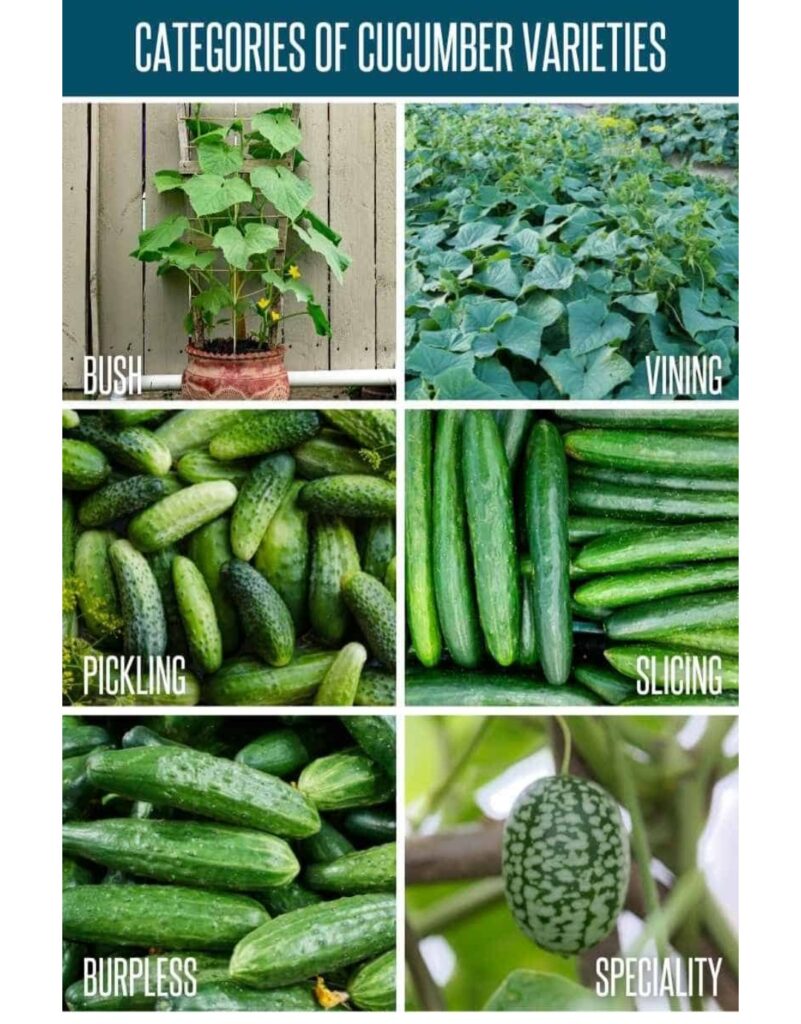
They types include:
a. The most commonly available type of cucumber is the hothouse or English cucumber. It is large, with dark green skin, and few or no seeds.
b. Armenian, or snake cucumbers: These are long and twisted with thin, dark green skin and pale furrows. People often use them for pickling.
c. Japanese cucumbers: These are dark green and narrow. The skin is thin with small bumps on it. People can eat them whole.
d. Kirby cucumbers: People often use these for dill pickles. They are crispy, with thin skin and small seeds.
e. Lemon cucumber: These are around the size of a lemon, with pale skin. The taste is sweet and delicate.
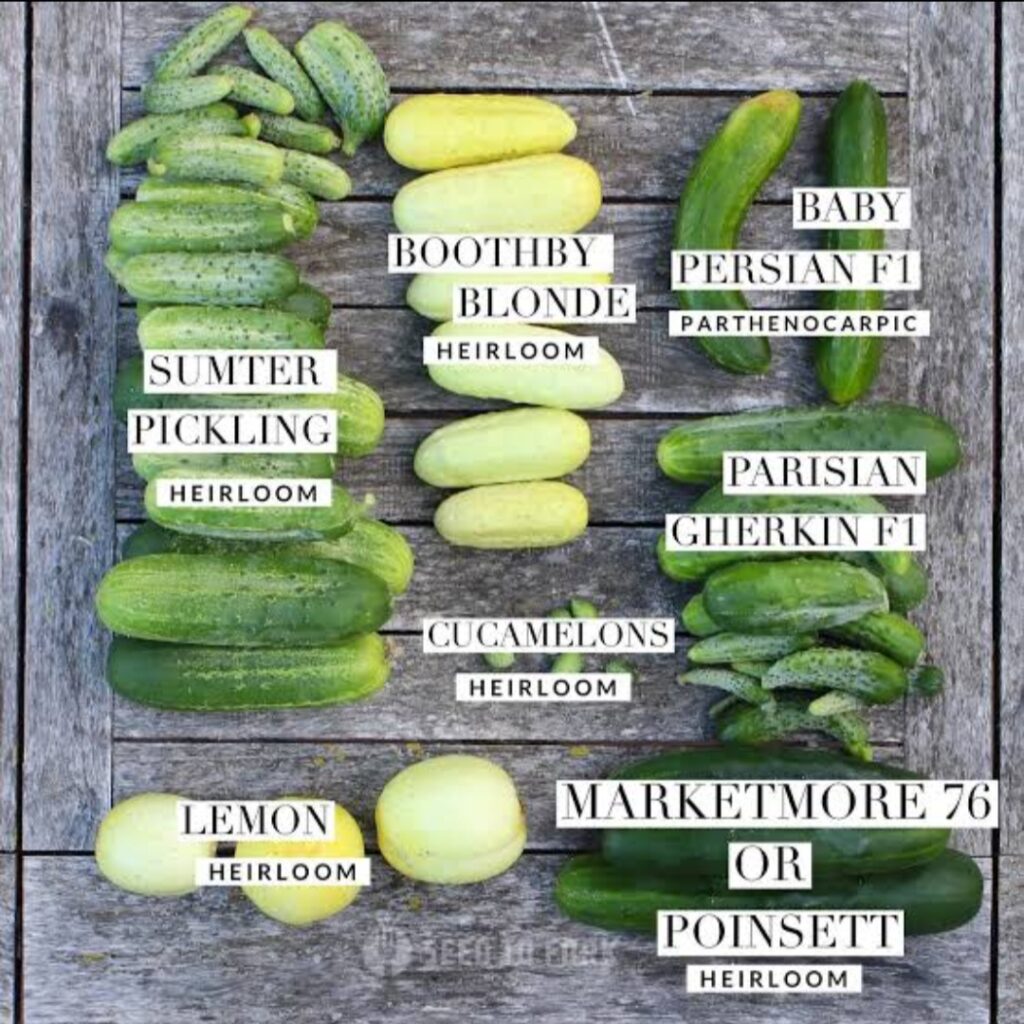
f. Persian cucumbers: Shorter and fatter than the hothouse cucumber, these are crunchy to eat.
g. The wild cucumber vine (Echinocystis lobata) is a fast-growing plant that is native to North America. Gardeners consider it a weed. Its fruits are not edible.
BENEFITS OF CUCUMBER
1) Hydration: Cucumbers consist mostly of water, and they also contain important electrolytes. They can help prevent dehydration in hot weather or after a workout. Staying hydrated is essential for maintaining a healthy intestine, preventing constipation, avoiding kidney stones, and etc.
For people who do not enjoy drinking water, adding cucumber and mint can make it more appealing.
2. Cucumbers are a nutritious food that contain many important vitamins and minerals. Cucumbers may also benefit skin health.
3. Cucumbers provide various nutrients but are low in calories, fat, cholesterol, and sodium.
4. Bone health:
Vitamin K helps with blood clotting, and it may support bone health. It helps improve calcium absorption. Together, these nutrients can contribute to good bone health.
5. Vitamin D is also important for bone health. Cucumber also contain vitamin D.

6. Cancer
As a member of the Cucurbitaceae family, cucumbers contain high levels of bitter-tasting nutrients known as cucurbitacin. Studies has proven that cucurbitacins may help prevent cancer by stopping cancer cells from reproducing.
7. Cucumber with its skin also provides around 1 g of fiber. Fiber may help protect against colorectal cancer.
8. Cardiovascular health:
Cucumber has high fiber content. The fiber can help manage cholesterol and prevent related cardiovascular problems.
9. Cucumber is also rich in potassium and magnesium. The Dietary Guidelines recommend that adults consume 4,700 mg of potassium each day and 310–410 mg of magnesium, depending on sex and age. By
reducing sodium intake and increasing potassium intake may help prevent high blood pressure.
10. The cucurbitacins in cucumber may also help prevent atherosclerosis.
11. Diabetes:
Cucumbers may play a role in controlling and preventing diabetes. It contains substances that may help lower blood sugar or stop blood glucose from rising too high.
The cucurbitacins in cucumber help regulate insulin release and the metabolism of hepatic glycogen, a key hormone in the processing of blood sugar.
Studies have also shown that cucumber peel can help manage the symptoms of diabetes in mice. This may be due to its antioxidant content.
Its Fiber too, may help prevent and manage type 2 diabetes, according to the AHA.
12. Cucumbers score low on the glycemic index (GI). This means they provide essential nutrients without adding carbohydrates that can increase blood glucose.
13. Inflammation:
Cucumbers may have anti-inflammatory benefits. Inflammation is a function of the immune system.
Experts believe inflammation may help trigger the development of various health conditions, such as:
cardiovascular disease
diabetes, autoimmune conditions, depression and
cancer
14. Skin care:
Some research has suggested that cucumber’s nutrients may provide benefits for skin health.
Applying sliced cucumber directly to the skin can help cool and soothe the skin and reduce swelling and irritation. It can alleviate sunburn. 16. Placed slice of cucumber on the eyes, they can help decrease morning puffiness.
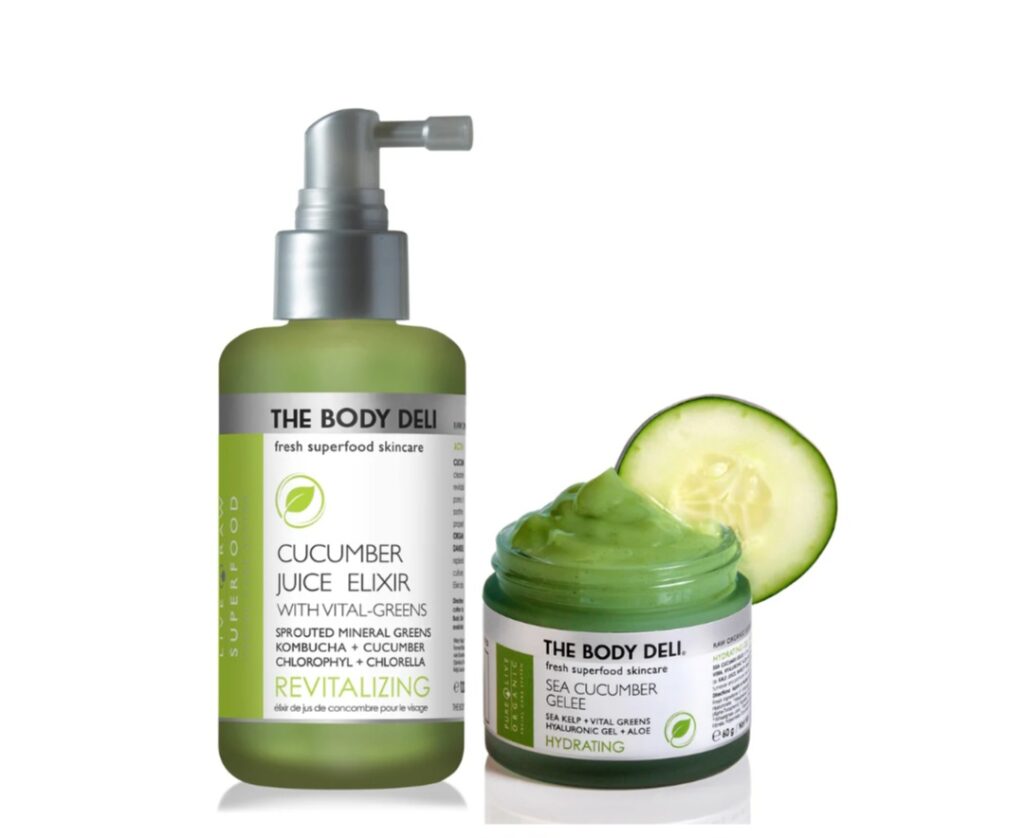
15. Cucumber has some beauty tips which include:
It is used as toner: The juice of cucumber is used as a natural toner. Rub and leave the juice on the skin for 30 minutes, then rinse. Cucumber may have astringent properties, and it may help clear the pores.
16. Face pack: Mixture of equal amounts of cucumber juice and yogurt can help make face pack that helps reduce dry skin and blackheads.
17. Cucumber also contains a range of B vitamins, vitamin A, and antioxidants, including a type known as lignans. Studies have shown that the lignans in cucumber and other foods may help lower the risk of cardiovascular disease and several types of cancer
18. Cucumber contain Antioxidants which help remove substances from the body known as free radicals. Some free radicals come from natural bodily processes, and some come from outside pressures, such as pollution. If too many collect in the body, they can lead to cell damage and various types of disease.
SIDE EFFECTS OF CUCUMBER
Cucumber is safe to eat, but it also comes with some side effects.
1. Digestive problems:
Some people find some types of cucumber hard to digest when consumed.
2. Blood clotting:
Cucumber is relatively high in vitamin K. Eating too much cucumber could affect how a person’s blood clots.
This gives reason why people who use warfarin (Coumadin) or similar blood-thinning drugs not to increase their intake of cucumber or suddenly without consulting a doctor.
3. Allergy:
Some people are allergic to cucumber when consumed. Anyone with a known allergy should avoid all contact with cucumber.
4. Do not consume the fresh plant on which cucumbers grows, only consume cucumber fruits. The cucumber leaves and stem have high concentration of cucurbitacins than the cucumber fruits which can cause toxicity. Rather, the young leaves and stems of the cucumber plant can be cooked as a potherb
CULTIVATION OF CUCUMBER
The cucumber undergo six growing stages- germination, seedling, vegetative, floral, fruit formation, and harvest phases. Most varieties of cucumber can be harvested between 50-70 days . It can be grown in frames or on trellises in greenhouses in cool climates and is cultivated as a field crop and in home gardens in warmer areas.
PROPAGATION: Cucumber are propagated by seeds. High quality, disease resistant varieties seeds should be purchased and planted.
CLIMATE
Cucumbers prefer warm weather with stable climate conditions:
TEMPERATURE: Most species of the gourd family are extremely sensitive to temperatures near freezing, a factor that limits their geographic distribution and area of cultivation. The ideal temperature for growing cucumbers is around 20–25°C during the day and 15°C at night. High temperatures can make cucumbers bitter.
HUMIDITY: Humidity should be around 60–70% during the day and higher at night. High humidity in wet seasons can promote leaf diseases.
LAND PREPARATION
Cucumber plantation requires well prepared and weed free field. To bring soil to fine tilth, 3-4 ploughings must be done before planting. FYM such as cow dung should be mixed with soil to enrich the field. Then beds are prepared having width of 2.5m and at the distance of 60cm.
SOIL
Cucumbers grow best in well-drained, fertile, sandy loam to sandy clay loam soil with a pH of 5.5–6.8. Avoid infertile or poorly drained soils, and locations with very high rainfall.
PLANTING/ SPACING: Cucumber seedlings planted in nurseries can be transplanted to the field or left in the nursery to produce fruits. Spacing recommendations for cucumbers vary somewhat among states and growing regions. For example, in United States, a recommended planting spacing of 48 to 60 inch rows, with a plant-to-plant, in-row spacing of 6 to 12 inches is used.
In Nigeria, two seeds are sown per place of bed of 2.5m wide and spacing of 60cm between seeds. The seeds are sown at the depth of 2-3cm.
METHOD OF SOWING:
• Low tunnel technology: This technology is used in temperate regions to produce early yield of cucumber in early summer. It helps to protect the crop from cold season i.e. in the month of December and January. Beds of 2.5m width are sown in the month of December.
• Dibbling method
• Basing method
• Layout in ring method.
WATERING
Cucumbers grown in low humidity conditions need a lot of water. The plant has a higher demand for moisture during pollination and fruit development. A water shortage can cause misshapen fruits, abortion, or less vigor to sprout secondary shoots. The fruits can also become bitter if exposed to uneven watering conditions.
FERTILIZER
Cucumbers require moderately low amounts of nitrogen (N) and higher amounts of phosphorus (P) and potassium (K). NPK fertilizer can increase fruit density, chlorophyll content, and shelf life. Typically, Split application are usually done. About half of the fertilizer is applied to the soil before planting or banded over the row at planting. The remaining amounts are put on as one or two early season sidedress applications, usually when plants begin to vine out
WEEDS CONTROL
Weed control are important management practices in cucumber farming. Cover crops and mulches, cultivation and hand weeding, and herbicides usage can be used to control weeds.
TRAINING AND PRUNING
Training and pruning of cucumber plants are important to promote proper growth, increase yield and improve fruit quality. Trellis or stake systems are best used for training cucumber.
In training cucumber, the trellis are used to hold the vines vertically. The trellis help save spaces, improve air circulation and make harvesting easy.

PRUNING: Cucumber plant should be pruned regularly so as to remove excess foliage, improve air circulation, and expose the plant to direct sunlight for fruit production. Lateral branches, sucker and damaged or diseased parts should be pruned.
GROWTH SEASON
The growth season for cucumbers is relatively short, lasting 55–60 days for field-grown varieties, and over 70 days for greenhouse varieties.
HARVESTING
Harvesting are done using the plants physiological factors such as colour, size, texture and sugar content.
Plants start yielding in about 45-50 days after sowing. Mainly 10-12 harvestings can be done. Harvesting is mainly done when the seed of cucumber are soft and the fruits are green and young. Harvesting is done with the help of sharp knife or any sharp object. The fruits must not be damaged during harvesting to give them a longer shelf life.
SEED PRODUCTION
Brown color fruits are best for seed production. For seed extraction, fruit pulp is taken out in fresh water for 1-2 days for the easy separation of seeds. The seeds are then rubbed with hands and as a result heavy seeds will settle down in water and then they are preserved for further use.
PEST AND DISEASES OF CUCUMBER
PESTS
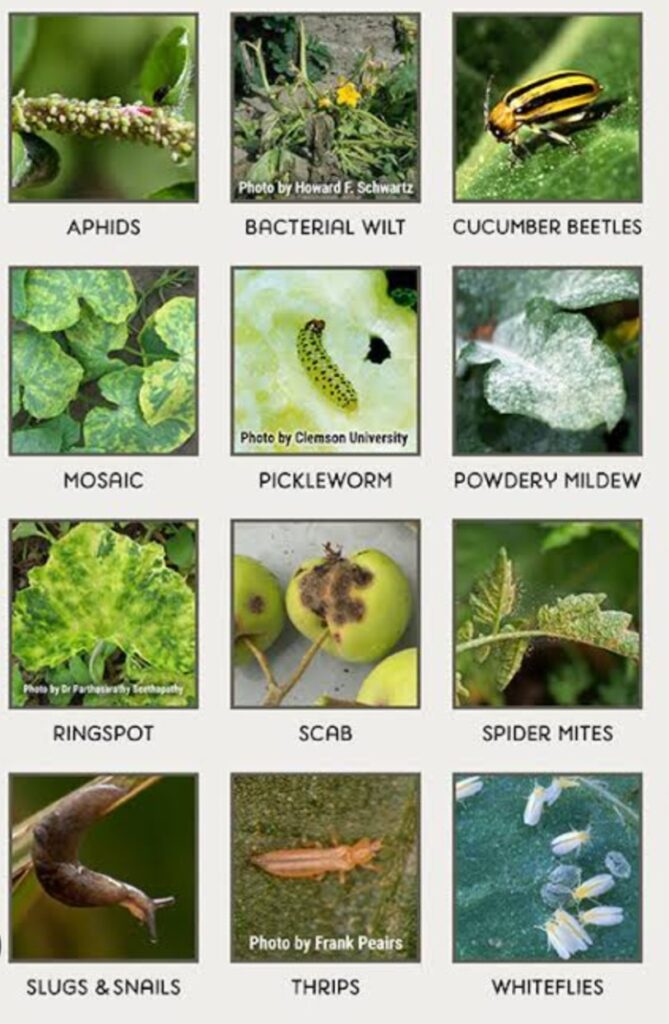
SQUASH BEETLE:
The squash beetle (Epilachna borealis) is one of two species of Coccinellidae that eat plant material rather than other insects. The squash beetle feeds upon the leaves of cucurbits. The other species, the Mexican bean beetle (Epilachna varivestis), a close relative of the squash beetle, is a serious bean pest.
SPIDER MITES
Two-spotted spider mites (Tetranychus urticae) can be a serious problem on cucurbits, especially on watermelons and cantaloupes, during hot, dry weather. These tiny mites feed on the contents of individual cells of the leaves causing a pale yellow and reddish-brown spots ranging in size from small specks to large whitish, stippled areas on the upper sides of leaves. The mites can kill or seriously stunt the growth of plants. Because of their small size, spider mites are hard to detect until vines are damaged with hundreds of mites on each leaf.
CONTROL: Spray insecticides at planting or as a foliar spray. Insecticidal soaps also offer adequate control when applied before the numbers are too high. Do not spray plants in direct sun or if plants are drought-stressed.
Spider mites can also be controlled with neem oil extract.
Mites can be removed with a strong spray of water. Predatory mites and beneficial insects, such as lady beetles and minute pirate bugs, are important natural controls measure.
MELON APHIDS
Melon aphids (Aphis gossyppi) and several other aphid species attack cucurbits, particularly melons and cucumbers. Melon aphids vary in size and colour from light yellow to green to black. Some are winged, while others are wingless.
They are found chiefly on the underside of the leaves, where they suck the sap from the plants and cause a reduction in the quality and quantity of the fruit. Infested leaves curl downward and may turn brown and die. The melon aphid also is one of the chief vectors in transmitting Cucumber mosaic virus. Usually, cucurbits are not attacked by aphids until the vines form runners.
CONTROL: natural controls using beneficial insects are extremely important in keeping aphid populations in check. In addition to natural enemies, Leaves can be sprayed with soapy water, then rinse with clear water. Spraying with insecticidal soap, planting in aluminum foil-covered beds, and filling yellow pans with water to trap the aphids are also effective control measures.
WHITEFLIES
Whiteflies are found in groups and at the underside of plant leaves.
Whiteflies are a common pest of cucurbit crops and may cause silverleaf disorder and vector (or spread) numerous harmful viruses. Whiteflies also weaken plants by feeding on their sap. They excreted Sticky honeydew as they feed. The excreted honeydew falls to lower parts of the plants and often develops and becomes covered with a dark-coloured sooty mold. This occurrence reduces the photosynthetic capability of the plant and can result in reduced yields.
CONTROL: Whiteflies can be managed culturally by providing proper nutrition and irrigation for plants. Also, reflective mulches can be used against whitefly feeding and disease transmission.
In addition, there are many beneficial insects that help manage whitefly populations, such as lacewings, bigeyed bugs, lady beetles, and minute pirate bugs. Many products effective against aphids are also effective in managing whiteflies.
MELONWORMS
The melonworm (Diaphania hyalinata) is a mid-summer to fall pest of summer and winter squash and cucumber in the United States. The pests migrate from tropical regions of Florida each year and usually arrive by late June or July to North Carolina. Higher population levels are usually observed in fall-planted cucurbits. After eggs are laid, the larvae (caterpillars) will undergo five instars before pupating. The later instars are pale to dark green with two horizontal cream-coloured stripes down the length of their back. The larvae feed on the leaf tissue, often leaving the veins intact, creating a skeletonized look. It is common to see leaves rolled or folded over to serve as a hiding spot as the melonworm pupates.
CONTROL: The melonworm usually completes its lifecycle within thirty days.
Spring planted cucurbits will escape most melonworm damage. In fall-planted gardens, careful scouting will help reduce infestations and damage. Many beneficial insects prey on or parasitize the melonworm, such as parasitic wasps, tachinid flies, ground beetles, and soldier beetles; therefore, farmers should avoid applying broad-spectrum chemicals, such as pyrethroids and neonicotinoids for melonworm management. Formulations of Bt and neem extracts can be used to manage melonworm and have less of an impact on beneficial insect populations.
DISEASES
The plants are susceptible to a number of bacterial and fungal diseases, including downy mildew, anthracnose, and Fusarium wilt etc.
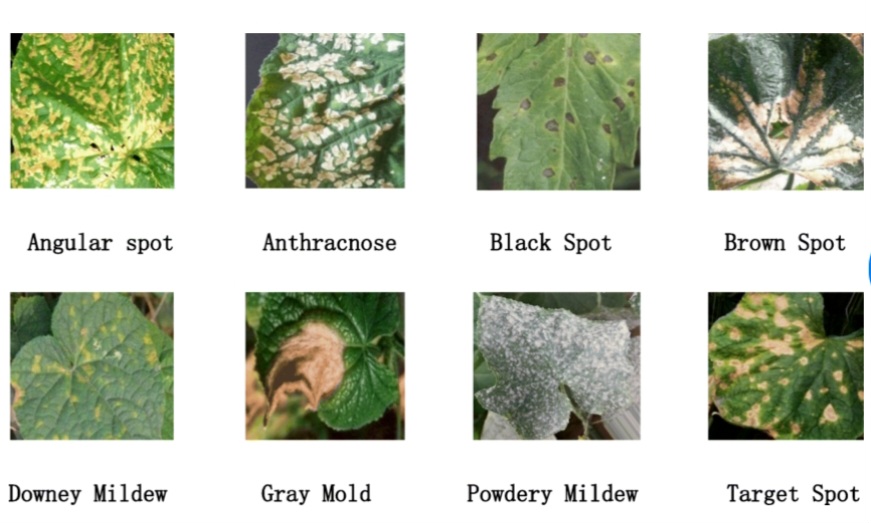
POWDERY MILDEW
It is a common fungal disease that appears as a white powder on the leaves, causing them to shrivel and stunting growth. Drought-stressed plants are more likely to get this disease.
DOWNY MILDEW
A fungal disease that causes yellowish spots on the upper surface of leaves, and a fuzzy, purplish-gray mold-looking growth on the undersides of leaves.
ANGULAR LEAF SPOT
It is a bacterial disease that causes small, water-soaked spots on the leaves that eventually become larger and angular in shape.
BACTERIAL WILT
A disease that primarily affects cucumbers and melons, but can also affect tomatoes, peppers, potatoes, eggplants, and corn. Cucumber beetles transmit the disease by creating wounds in the plant for the bacteria to enter.
CUCUMBER ANTHRACNOSE
Anthracnose is a fungal disease that not only affects cucumbers but also other cucurbits and beans (Phaseolus). They are caused by Colletotrichum fungi. The symptoms include small brown spots and marks on the foliage, which rapidly grow in size and develop a yellow edge, as well as pink mould developing on the stems and stalks. Anthracnose can be spread by contaminated seed and airborne spores and is encouraged by warm and moist conditions, such as when grown in glasshouses, but it can affect outdoor grown plants as well.
CUCUMBER SCLEROTINIA DISEASE
This disease is also known as white mold. It is caused by the fungus Sclerotinia sclerotiorum. It is a fungal disease that can cause problems when growing cucumbers. It also affects both vegetable and ornamental plants. Sclerotinia fungi can unfortunately live for a long time in the soil. It primarily occurs as a stem blight or fruit rot.
The disease may cause cucumber plants to deteriorate rapidly. It also show symptoms of yellowish foliage, wilting, rotting stems and a white fluffy substance forming on the stems and fruit. PREVENTION AND TREATMENT: To prevent cucumber sclerotinia disease, grow cucumbers in new compost each year. Currently, there is no remedy and infected plants must be destroyed.
CUCUMBER MOSAIC VIRUS
Cucumber mosaic virus is a common viral disease that can affect not only cucumbers and cucurbits but also spinach (Spinacia oleracea), lettuce (Lactuca sativa) and some ornamental plants.
Symptoms include distorted and yellowing cucumber leaves with a mosaic pattern and reduced plant growth, resulting in reduced yields and misshaped fruits.
Mosaic virus is most often spread by insects, especially aphids. However, it can also be transmitted by infected garden tools and after handling other cucumber plants with the virus.
CUCUMBER ROT
Cucumber rot can affect different parts of the cucumber plant from the roots (root rot) to the stem (basal stem rot).
Root rot encompasses several fungal diseases that target the roots of cucumber plants with the worst being black root rot (Phomopsis sclerotioides). It often occurs later in the growing season, clear signs on inspection are rapid wilting as well as brown and black lesions on the roots.
CUCUMBER GREY MOULD
Grey mould (Botrytis cinerea) is a common fungal disease that can affect numerous plants, including cucumbers. It normally affects already struggling plants or gets in through wounds, but the high humidity in a greenhouse or rainy season can increase its likelihood.
The main symptoms include grey-brown mould on the stems, stalks and fruit, which often occurs after pruning cucumbers and causes dieback above the infected area.
CONTROL: Remove and destroy affected plants.
